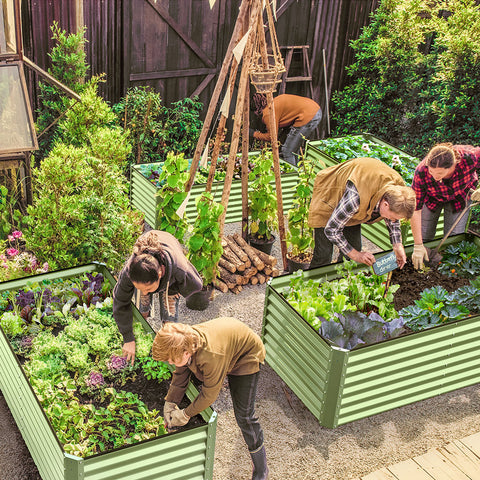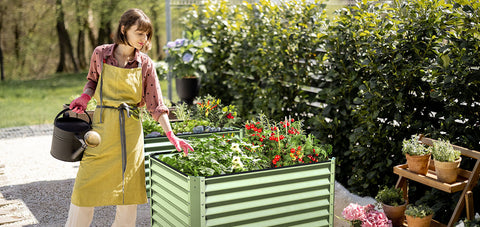Nothing says your green thumb like an efficient raised bed watering system. Whether you choose a drip irrigation, soaking hose, sprinkler system or automatic watering system, you will save a lot of time and effort after the installation is complete. Especially with raised garden beds, irrigation systems can prevent a lot of problems. Say goodbye to uneven sprinkling water, water-borne diseases, and say hello to water conservation! Using a soaking hose or dropper, it is not possible to get water where it is needed on the ground. It will happen.The following content also has some reference value for raised garden beds.
Systematic irrigation is one of the best things anyone can add to a vegetable garden. If you want, you can drop water into certain areas and exclude more drought-tolerant areas from the system. Let's talk about installing an irrigation system so you can enjoy the green.
Watering system or hose?
While garden hoses are a perfectly appropriate way to water plants, there are benefits to switching to an irrigation system. By watering the root zone, you can transfer water directly to the plant and avoid water-borne diseases such as powdery mildew or other fungal spores that cling to moist leaves. The system also prevents water from evaporating from the plant's leaves, which can end up as waste water that promotes disease. The irrigation system allows you to wake up, turn it on, walk in the garden every day, and then turn it off. Instead of dragging hoses around the garden, you can focus on checking your plants to make sure they are healthy and strong. With an automatic system like a hose timer, you don't even have to turn it on and off. This will give you time to relax in the morning. This allows you to go for a walk in the garden at the most convenient time.
A hose that can hold a lot of alcohol
Soaking hoses are a great way to gradually irrigate plants while transporting water to the root zone. Absorbent hoses, usually made of rubber or polyurethane, have dozens of small holes that slowly drips water into the garden. The outer layer of these types of immersion hoses is usually made of cloth. Another form of soaking hose is made from recycled rubber, which is completely porous and allows water to flow out along its entire length. The benefit of a soaking hose is that you can simply place it in your lifting bed to water existing plants. Especially if you are a square foot gardener, a soaking hose is a great alternative to a drip irrigation system. One feature of immersion hoses over drip irrigation is that they do not require any form of installation other than hose placement and connection to the main water source.
Drip irrigation
A drip irrigation system on raised beds provides gardeners with a stylish design and efficient watering of plants. Some systems contain multiple parts that you can assemble yourself, and others contain basic parts that you can add as needed. Every drip irrigation system comes with hoses or pipes that are either pre-perforated or perforated by you. When connected, they slowly drop water into raised garden beds, and they can be placed in specific plants and areas. Systems that allow you to poke holes make it possible to design water-conservative irrigation in your own garden.
Drip irrigation systems can also include a variety of drip irrigation heads. They range from simple hose holes to accessories that more effectively control irrigation flow. If you think a hole in a pipe could be your main source of water, look for a porous pipe, drip tape or laser tube. If you're working with water that contains a lot of minerals, these types of transmitters can easily clog up. Instead, use a sprinkler launcher, which drains water from the ground as it would in a sprinkler system. The water strength in the sprinkler is higher than the porous hose, but no ordinary sprinkler. In a raised flowerbed, you can set up a system to direct the line into the raised flowerbed garden and then out through the protruding sprinkler heads. This is perfectly acceptable for garden irrigation systems, especially in plants that are not prone to mold.
How do you build a system
Depending on your preferences and equipment, the difficulty of installing a soaker hose or drip system varies. Before you install a drip irrigation system or soak hose in your garden to lift the bed, consider the following points.
Main water source
Start with the main water source. Does it come from a rain barrel or a well pump? Or do you have a tap on the side of the house that you want to use for irrigation and seedlings? Is your preferred system using PVC pipe or flexible hose? Do you connect regular methods to other systems? Most importantly, what is your biggest garden inspiration?
Once you've taken the time to think about these things, you can plan how to set up the water pipes from the main water pipe to the garden bed. An important question to consider is: Will the pipe go from the main pipe to the garden above ground or below ground? While a buried pipe is aesthetically pleasing, it requires more setup than a simple garden hose placed above ground. However, buried pipes prevent tripping hazards in the garden. Decide whether you will follow the pipes along the side of the raised flowerbed garden or bury them into the garden grid. If you haven't set up your high bed yet, great! This means you have more room to install a new underground drip system. If you have installed a bed and you are worried about a tripping hazard in the garden, cover the hose with a few inches of mulch to prevent tripping.
Hose diameter
The diameter of the hose varies according to the purpose of irrigation. A wider pipe will deliver more water to the bed, while a smaller hose will deliver less water. First, determine how and how much water you want to provide. Then check if you can make adjustments as you go along. Most conventional tubing (including flooded tubing) was ¼ inch, ½ inch, ⅝ -in., and ¾ inch. Main lines may be between one and three inches wide because of the amount of physical forces they must withstand. Most drip irrigation kits come with 1/4 inch or 1/2 inch tubes that can be attached to the main line. A rule of thumb: The greater the pressure, the wider the hose.
Water pressure
Most drip systems operate effectively at 25 psi, but can handle lower pressures at 15 psi. If the strength of the dropper is too low, you will have erratic watering. If the amount is too large, system components may fall off or the hose may burst. There are ways to regulate higher strength through droppers, which we will discuss in the next section. Lower pressures are more difficult to regulate and often require users to install systems specifically designed to handle lower flows. Thankfully, there are a number of suitable diameter hoses on the market that can deliver more water directly to plants than regular hoses. If you're not sure which system provides the best water for your plants, measure the strength with a pressure gauge you bought at your local hardware store.
All kinds of equipment
Now that we've laid out the basics of watering plants in your garden, let's talk about other additions to improve your gardening journey. Pressure controllers are a good choice for high voltage sources. They are available in low, medium and high traffic formats. If you know high pressure is a problem, the controller will adjust so that you can water directly without losing equipment or bursting it in the process. Another problem many people have when watering their plants is hard water, which is rich in minerals and can overwhelm plants and soil. In this case, a hard water softening system is installed at the source of the pipe. These remove excess minerals from the water and keep the soil healthy and stable. Filters, related to hard water softeners, remove excess minerals through a filtration system that runs from a small screen in a hose to a full pump. More sophisticated filters may not be necessary in your gardening practice. A very small hose connection may be sufficient.
One way to make your watering fully automatic is to install a timer at the source that can turn irrigation on and off without the need for human intervention. Some timers are solar-powered and can sense sunrise and sunset to turn them on and off. Some are high-tech, controlled by an app on your phone. While timers are great when they work, sometimes they break or don't work properly. If you have a little extra money, consider a timer that works through a specific time instead of solar timing. Timers are a great watering method to save some effort in gardening during the summer months when evaporation is a problem. A properly running timer will help you cut down on the time you spend lugging your hose around in any season.
Mix and match system
Water supply system layout
This watering system utilizes a head and foot line with drip tape between them.
One way to experiment with different watering systems in your garden is to mix and match watering methods. If you are growing conventional crops, the above results are from Youdao Neural Network Translation (YNMT) · General field
Installation procedure
No matter what the season, it's never too late to set up a raised bed watering system. Follow these steps to keep your garden filled with lush greenery all year round.
Do some research. Know what your plants need, what soil fill and seeds need in your bed, and determine which system is best. Consider the main source of water in your yard, current strength and mineral content. Watch a video on different irrigation methods (or, like the one Kevin linked to earlier, dedicated to drip irrigation) and use that video to find products that fit your needs and budget.
Draw your pattern. An intuitive understanding of the design helps you plan. Here, how much you want is specific or general, including the actual size and scale.
Find and purchase equipment. Choose a complete kit or assemble the parts yourself. Consider hose diameters, transmitters, and any other items you may need.
Spread out the pipe. Before you start the installation, make sure your design is working properly and that everything is where it should eventually be.
Continue to install. This is the hardest part, but also the most important! If you are using the kit, follow the instructions. Otherwise, stick to the design, it's OK!
Sit back, relax, and enjoy the extra time and money you've saved. Now you have a system where you don't have to work so hard in the garden and your plants are happier. Make any adjustments as you go









